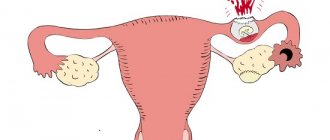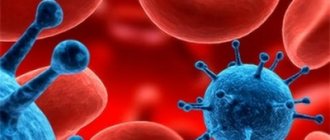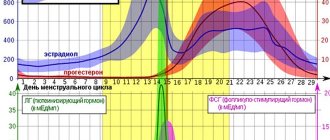What is the endometrium?
The endometrium is the thin, mucous inner lining that lines the uterus. It is densely permeated with capillaries. Depending on the period of the cycle, the activity of blood circulation in it fluctuates. The endometrium tends to grow due to the activity of estrogen during the 1st half of the cycle.
From the second half, the organ begins to prepare for the implantation of the egg; for this, progesterone is actively produced. If this event does not take place, then the level of progesterone drops, the mucous membrane exfoliates and is rejected at the end of the cycle.
The endometrium is one of the most important elements of the normal state of women's health. Its thickness is an indicator of the correct hormonal balance, since the state of the dynamic mucosa directly depends on the cyclic replacement of one hormone with another.
Endometrial thickness for conception and pregnancy
So, we found out that the endometrium is one of the important elements of conception. The ability to get pregnant depends on:
- Thickness and structure of the endometrium;
- Successfully achieving the desired threshold of maturity of the superficial endometrial glands.
It is these moments that ensure, in fact, the attachment of the fertilized egg to the walls of the uterus and the beginning of its development into an embryo.
The maturation of the endometrium depends directly on estradiol , a hormone produced during the proper development of follicles.
Estradiol provides:
- Endometrial maturation;
- The accumulation of receptors for progesterone , another important hormone, in the endometrial epithelial tissue.
Pregnancy will not occur if for some reason the endometrium does not mature. Reasons that cause such problems include:
- Congenital conditions in which the production of necessary hormones is insufficient or absent;
- Hormonal – if for some reason a woman’s hormonal background does not allow the endometrium to reach the desired phase of development at the right time (thin endometrium);
- Blood supply disorders in the uterine area - congenital or acquired. Similar problems can arise after injuries, inflammation, diseases of the uterus and adjacent organs, as well as as a result of abortion;
- Injury to the endometrium itself , usually resulting from an abortion. Complete removal of the endometrium during active curettage is extremely rare, but even partial removal of this layer makes pregnancy very difficult.
Depending on the causes of disturbances in the maturation and development of the endometrium, the doctor prescribes certain medications. And traditional medicine knows its own ways to help cope with this problem.
Functions of the endometrium
The endometrium by day of the cycle, the thickness standards of which must correspond to the indicators established by the WHO in order for all its functions to be fully realized, changes throughout the entire cycle. This constant renewal ensures the normal functioning of the tissue.
The endometrium has several main functions:
- prevents aging of the uterine walls;
- does not allow the walls of the uterus to stick together during the period when the woman is not pregnant and the walls are in contact;
- promotes the implantation of the embryo and its further development;
- during the period of bearing a child, it ensures an increase in the number of capillaries and glands;
- completely supplies the embryo with everything necessary - nutrients and oxygen due to the blood supply to the placenta.
Why doesn't the endometrium grow?
This layer of fabric performs a very important function. The fertilized egg is attached there. The endometrium creates the right conditions for the development of the embryo. Once conception has occurred, the number of glands and blood vessels increases, which subsequently become part of the placenta. They provide the fetus with oxygen and nutrients. For conception to occur, the endometrium must be of normal quality, thickness, structure, and degree of maturity. However, it may not grow naturally due to the following reasons:
- Congenital pathologies. With such abnormalities, the body does not produce certain hormones in order to grow the endometrium, or their quantity is insufficient.
- Hormonal imbalances. With some of them, the natural growth of the endometrium does not occur on the days of the cycle. Normally, throughout the entire period, the thickness of the mucous membrane layer gradually increases and decreases.
- Poor blood supply to the uterus. This phenomenon may be a consequence of injury, inflammation, diseases of the pelvic organs, or abortion. With the latter, the endometrium is damaged as a result of curettage. This significantly reduces a woman's chances of becoming pregnant in the future.
- Hypoplasia of the uterus. This is the name for the discrepancy between the size of an organ and the age norm. With this pathology, the layer of the mucous membrane needs to be increased.
- Duck in the oven - cooking at home, step-by-step recipes with photos. How to bake a bird
- Jam in a multicooker Redmond
- How to remove fleas from a cat
Fabric structure
The uterus contains several levels of tissue:
- outer layer – serous;
- middle layer – muscle layer, myometrium;
- internal – mucous layer, endometrium.
The endometrium itself also consists of several components:
- glandular epithelium;
- stroma – connective tissue;
- main substance;
- cover epithelium;
- expanded circulatory system.
According to its functions, the endometrium is divided into 2 main layers:
- Basal - it is located closer to the myometrium, is practically not subject to cyclic changes, and is rich in branching vessels coming from the muscle level. The basal layer is the soil for fastening, nutrition and development of the functional layer; its dimensions range from 1 to 1.5 cm. It contains a dense network of glands, which, growing from this level, tend to penetrate the functional layer.
- The functional or dynamic layer experiences great changes throughout the cycle. The outer surface is formed by cuboid cells, the middle level is made of glandular cells. The spaces between cells are filled with stroma. The functional layer is able to grow significantly, preparing to receive a ready-made egg; for this, the activity of the blood supply increases significantly. If pregnancy does not occur, the dynamic layer peels off and is expelled, then, with a new cycle, the layer is revived.
Stages of endometrial development
The duration of the female cycle is 1 lunar month, that is, 28 days.
It can be divided into several main periods:
- desquamation – detachment of the dynamic layer and the start of bleeding;
- regeneration – launching restoration processes of the dynamic layer;
- proliferation is a time of active changes in the basal layer of the endometrium;
- secretion - active growth of the functional layer, germination of blood vessels and glands, enlargement of the mucous membrane.
How and why is endometrial thickness measured?
The dimensions of the internal mucosa of the main female organ are measured during an ultrasound examination of the pelvic organs.
During the implementation, the following is additionally assessed:
- analysis of the structure of the endometrium, identification of areas of increased echogenicity and heterogeneity throughout the entire layer;
- myometrial condition;
- analysis of the condition of the uterine appendages, features of the functioning of the ovaries depending on the period of development of the endometrium, and on whether the woman takes hormonal drugs;
- the condition of the vessels located in the pelvic cavity.
Treatment
Its treatment is aimed at increasing the thickness of the inner layer of the uterus and is carried out with the help of medications. If cyclic changes in a woman’s body are disrupted, treatment is carried out with hormonal drugs: estrogens on the 5th day of the cycle - Progynova or Divigel, estrogen-gestagens from the 1st day of menstruation throughout the entire cycle with or without a seven-day break - Femoston or Yarina, or progestins in the second phase of menstruation cycle - utrozhestan or duphaston. The use of hormones allows you to increase the thickness of the endometrium, while it becomes mature and ready for implantation of a fertilized egg. Very often, depending on the identified cause, treatment is carried out with antibiotics, anti-inflammatory drugs or the use of homeopathic remedies.
Enlargement of the endometrium with folk remedies
A forum with reviews from women points to such traditional medicine as boron uterus, sage, and the use of foods enriched with vitamin E and C in the diet. Borovaya uterus decoction is used both for oral administration and for douching. Sage decoction is used for oral administration in the first phase of the menstrual cycle. Milk, citrus fruits, black currants and flax seeds are used as vitamin-enriched foods.
A special place in the treatment of thin endometrium belongs to reflexology and treatment with leeches, a set of physical exercises that stimulate blood flow to the pelvic organs. All these methods should not be used independently, but only after consultation with a doctor, because it is the doctor who can recommend this or that method of treatment.
Based on the above, it is clear that in the onset of pregnancy, namely in its implantation, an important place belongs to the thickness of the endometrium. And if it is insufficient, then there are problems with conception, or rather its absence. That is why the most important thing in the treatment of infertility is the thickness of the endometrium, since the probability of implantation of a fertilized egg into the uterus depends on its size. It is thanks to an integrated approach to the treatment of this condition that the likelihood of pregnancy increases.
Table of endometrial norms (mm) by cycle day
The endometrium, according to the days of the cycle, the thickness standards of which have already been determined by specialists, changes every month according to the same pattern.
| Endometrial development phase | Stage of endometrial development | Cycle day | Thickness in mm, features of the layer condition |
| Bleeding | Desquamation | 1-2 | 5-9 – separation of the active layer is still ongoing, it has not yet reached the minimum values |
| Regeneration | 3-4 | 2-5 – minimum values of the mucous layer | |
| Proliferation | Early | 5-7 | 3-7 – the thickness value begins to increase |
| Average | 8-10 | 7-10 | |
| Late | 11-14 | 10-14 | |
| Secretion | Early | 15-18 | 10-16 |
| Average | 19-23 | 10-18 – thickness tends to maximum values | |
| Late | 24-27 | 10-17 – a few days before rejection, the thickness decreases slightly by 2-3 |
Endometrial norms by phase
The endometrium develops in several phases, each of which has its own characteristic features.
Bleeding phase
The beginning of this period starts on the first day of the female cycle. Rejection of the dynamic layer and its exit from the uterine cavity provokes the onset of bleeding. The length of this process depends on personal characteristics and whether the woman is taking women's health medications.
In most cases, the bleeding period lasts from 4 to 7 days and occurs in 2 stages:
- Rejection occurs on days 1 and 2 of the cycle. The endometrium here is no more than 5-9 mm.
- Regeneration occurs in the interval from 4 to 7 days. The endometrium now shows a minimum size of 3 mm. The dynamic layer has already been torn away and the process of its restoration has begun, readiness is being formed with rapid growth.
Proliferative phase
It starts on the 5th day of the cycle and continues from 14 to 16 days. The task of this time is to prepare the ground for the rooting of the finished fertilized egg.
Consists of 3 stages:
- Early. Duration – from 5 to 7 days. The size is initially 5 mm and increases by 1 mm every day.
- Average. The mucous membrane is actively changing, rapid growth is observed. On day 8 the size is 8 mm. The stage lasts until day 10, by which time a size of 10 to 12 mm is reached.
- Late – at this stage, proliferation is completed, duration is from 10 to 14 days. The thickness of the dynamic layer is already quite large. The maturation of the follicles begins, by the 10th day their diameter becomes 10 mm, by 14-16 days it is already 21 mm.
Secretory phase
It is considered the most significant. The structure of the mucous membrane undergoes the most significant changes at this time.
Endometrium by day of the cycle. The standards are indicated in the photo.
It also occurs in 3 stages:
- Early – active tissue remodeling from 15 to 18 days. The mucous membrane grows from 12 to 16 mm.
- The average period takes 19-24 days. Average thickness is 14-16 mm. The maximum value is 18 mm; if it is exceeded, a specialist may suspect pathology.
- The late stage starts on day 24 and ends on day 1 of the new cycle. The size of the inner shell decreases slightly, the mucous membrane thickens, the average value is 12 mm, the maximum values do not change and are 18 mm, they should not be exceeded.
If an increase in thickness indicators is detected, additional examinations are prescribed to clarify the causes and condition.
Normal for delay
The endometrium according to the days of the cycle, the thickness norms of which will also depend on the duration of the woman’s entire cycle, will not matter if its thickening is delayed.
Cycle length standards are determined by specialists in the range of 21-35 days.
As the cycle increases, an increase in the phases of endometrial development occurs, but excessive tissue growth does not occur. On the contrary, in case of delay, it is possible that the mucous membrane has not grown to the required thickness and has not gained the critical mass at which its rejection occurs.
The duration of each phase increases slightly and so there is a general increase in the cycle. The most common problem that provokes a delay is a disruption of the hormonal rhythm.
It is caused by several problems:
- physical and emotional stress;
- unbalanced nutrition;
- diets with a significant calorie deficit;
- a sharp decrease in body weight;
- diseases of the endocrine system;
- diseases of the female reproductive system.
If there is a delay, the state of the endometrium remains at the level of secretion with indicators of 12-14 mm. Most often, the delay ends on its own and menstruation occurs. In difficult situations, it is necessary to take stimulant medications, which are prescribed only by a doctor.
The importance of the endometrium in planning
For some women, the answer to the question of why their pregnancy does not occur is obvious. The mucous membrane is a factor that ensures the creation of an ideal environment for the attachment of the fetus to the body of the uterus. For extensions, special medications are used, which are prescribed by a gynecologist.
With the desire to get pregnant as quickly as possible, girls resort to self-diagnosis or prevention using folk remedies, which ultimately causes hormonal disorders and deterioration of the condition. How to grow the endometrium without harm to the body? Watch the video where the doctor answers the most frequently asked questions.
The importance of the mucous membrane during conception is undeniable. The first and main function is the implantation of a fertilized cell at the first stage of conception. The mucous membrane also plays a role during the menstrual cycle, changing its indicators with changing phases.
The membrane thickens towards the end of the menstrual cycle in order to attach the embryo, but if the egg has not been fertilized, the process of hatching begins - what we call menstruation.
The uterine tissue itself is very dependent on hormones and is one of the indicators of a sufficient amount of estrogen. At the end of the ovulation period, the proliferation phase begins - the tissue becomes thicker and more nutritious, which allows the embryo to consolidate.
Often, the maturation of mucous tissue does not occur due to diseases of the circulatory and reproductive systems, therefore, when planning a pregnancy, it is recommended to undergo an examination of the body in advance.
Thickness during pregnancy
If a fertilized egg is attached, the functional layer will not peel off; it is preserved to support the life of the future fetus. At first, the thickness remains at the same level as when the egg was implanted.
Next, the endometrium begins to gradually grow and after 3-4 weeks reaches a thickness of 20 mm. This indicator is also considered one of the signs of a successfully implanted egg, regardless of the presence of ultrasound imaging.
Normal for long cycle
The menstrual cycle lasts in most cases in the range of 21-35 days. It depends on the woman’s heredity, individual characteristics and general health. Endometrial indicators, regardless of the duration of the cycle, change according to all stages.
If the cycle deviates from the classic indicators - 28 days, the duration of the stages of endometrial formation changes, but the thickness does not fall below the minimum limit and does not increase beyond the maximum value.
If the cycle differs in duration from the norm, ovulation will shift depending on the total duration:
- with a short cycle, ovulation occurs earlier;
- with a long cycle - later.
Standard indicators during menopause
At the beginning of menopause, endometrial indicators have not yet reached constancy. With the cessation of menstruation, the need for constant changes in the endometrium disappears. The hormonal background stops fluctuating and a normal balance of hormones for menopause is formed.
As soon as menopause is established, the endometrium reaches a value of 5 mm and has not changed since then. An increase in indicators creates the likelihood of developing pathological neoplasms. 10 years after the onset of menopause, endometrial indicators should not be more than 3 mm. This figure should not increase either.
Norm for physiological conception and IVF
The endometrium according to the days of the cycle, the thickness norms of which will be of particular importance in preparation for conception, must correspond to the monthly phase, otherwise the finished egg will not be able to take root in the tissues of the uterus. Both for a self-flowing process and for IVF, the desired thickness of the endometrium is the same - from 9 to 11 mm.
If these indicators are not achieved, the egg will not be implanted or the pregnancy will be terminated. When performing IVF, the likelihood of implantation of a fertilized egg is lower than during an independent pregnancy. Therefore, to ensure success, methods are used to prepare the mucosa and to build up the required thickness. If the required thickness has not been achieved, the IVF procedure will be cancelled.
Causes of thin endometrium
Very often, women who cannot get pregnant learn that the thickness of the endometrial layer of the uterus is small and implantation of the fertilized egg does not occur. This occurs due to hormonal dysfunction, uterine abnormalities, endometritis, circulatory disorders or as a result of mechanical effects on the uterus, such as curettage, as well as a number of endocrine diseases and hereditary pathologies are factors leading to thinning of the endometrium and its underdevelopment. Therefore, many of them are interested in how to enlarge the endometrium when planning pregnancy?
Endometrium when taking COCs
Oral and other hormonal contraceptives affect the body in a certain way, slowing down and weakening some processes in order to make conception impossible.
For example:
- hormonal contraception disables the process of maturation and release of the egg from the ovary, so ovulation does not occur;
- hormonal drugs make the mucus in the lumen of the cervix thicker and more abundant, thus preventing sperm from penetrating into the uterine cavity;
- contraceptives reduce the activity of the mucous membrane of the fallopian tubes, which normally promotes the advancement of the egg into the uterine cavity;
- the drugs also have an effect on the endometrium itself, it becomes thinner, especially its mucous layer, which ensures the attachment of the fertilized egg.
Often, all the described effects of hormonal contraceptives are the main goal, as they create optimal conditions for the treatment of certain gynecological problems and recovery from diseases. In such a situation, the contraceptive effect is secondary and is a pleasant addition to the main effects of the drugs.
Various methods of endometrial augmentation
One of the causes of infertility or chronic spontaneous abortion may be a thin endometrium. Although not only the thickness of the endometrium is important, but also its structure, blood circulation, arterial lumen, etc., nevertheless, often only an increase in thickness can already give a positive result.
Endometrial thickness value
has several layers, including . With each menstruation, the functional layer is torn off and comes out with blood from the vagina. Subsequently, under the influence of reproductive hormones, it increases. The functional layer reaches its maximum thickness in the premenstrual period, when a fertilized egg, if any, descends into the uterine cavity and is implanted into it. Thus, ultrasound measures the thickness of the functional layer, which depends on the duration of the menstrual cycle. If at the time of implantation of the egg the thickness of the endometrium is insufficient, then the embryo will not find a place for implantation and pregnancy will not occur, or a spontaneous abortion will occur due to its poor attachment. At best, there may be placenta previa.
How to grow the endometrium with medications
Since the endometrium is a tissue, it can be increased exclusively with hormonal drugs. Under the influence, endometrial maturation occurs, when young cells of the functional layer mature and become ready to receive an embryo. Estradiol also promotes the accumulation in the endometrium of specific receptors sensitive to progesterone, which affects further changes and thickening of the endometrium to maintain pregnancy. It must be taken into account that it is important not only to know how to grow the endometrium, but also to create conditions for its proper maturation.
How to grow the endometrium without drugs
A very important point for the full maturation and growth of the endometrium is good blood supply in the pelvic area. This is facilitated by physical exercise, especially belly dancing. When working sedentarily, you must additionally engage in any kind of non-strength sports, that is, running, swimming, dancing, and so on.
How to grow the endometrium using folk remedies
Very good for the growth and maturation of the endometrium (second name -) and. These herbs should be consumed according to the scheme, dividing the menstrual cycle into two halves. The first is after menstruation and before the middle of the cycle. During this period, you need to drink red brush (the medical name is Rhodiola colda), and in the second half - boron uterus. By the beginning of menstruation, as it should be according to the cycle, the amount of medicinal decoction consumed should be gradually reduced until completely eliminated. During menstruation, if pregnancy has not occurred, you need to take a break.
Herbal decoction
Pour a glass of hot water, almost boiling water, over a tablespoon of herbs and leave for 4 hours, in a thermos. Store in the refrigerator and drink a spoonful every 6 hours.
Share with your friends!
Why is the endometrium needed, what should it be like?
The endometrium is the lining of the uterus . This is a system that consists of many components, in particular:
- Epithelium – integumentary and glandular;
- Blood vessels;
- Stroma - supporting, connective tissue, which during menstruation develops into mature cells that produce collagen and a number of other substances.
Creating favorable conditions for the attachment and development of the embryo in the uterus is the main function of the endometrium. If conception occurs, the number of blood vessels and glands begins to grow in the endometrium in order to:
- The endometrial vessels have become part of the placenta;
- Oxygen was delivered to the developing fetus;
- The embryo received nutrients.
Endometrial thickness for conception and pregnancy
So, we found out that the endometrium is one of the important elements of conception. The ability to get pregnant depends on:
Preparing the endometrium before IVF
- Thickness and structure of the endometrium;
- Successfully achieving the desired threshold of maturity of the superficial endometrial glands.
It is these moments that ensure, in fact, the attachment of the fertilized egg to the walls of the uterus and the beginning of its development into an embryo.
The maturation of the endometrium depends directly on estradiol , a hormone produced during the proper development of follicles.
- Endometrial maturation;
- The accumulation of receptors for progesterone , another important hormone, in the endometrial epithelial tissue.
Pregnancy will not occur if for some reason the endometrium does not mature. Reasons that cause such problems include:
- Congenital conditions in which the production of necessary hormones is insufficient or absent;
- Hormonal – if for some reason a woman’s hormonal background does not allow the endometrium to reach the desired phase of development at the right time (thin endometrium);
- Blood supply disorders in the uterine area - congenital or acquired. Similar problems can arise after injuries, inflammation, diseases of the uterus and adjacent organs, as well as as a result of abortion;
- Injury to the endometrium itself , usually resulting from an abortion. Complete removal of the endometrium during active curettage is extremely rare, but even partial removal of this layer makes pregnancy very difficult.
Depending on the causes of disturbances in the maturation and development of the endometrium, the doctor prescribes certain medications. And traditional medicine knows its own ways to help cope with this problem.
Effective ways to grow the endometrium: medications
medications are usually used . It should be noted that thin endometrium is difficult to treat.
Since the growth of the endometrium directly depends on estrogen, accordingly, the following is prescribed:
- Hormonal treatment: as a rule, these are injections of estradiol, Divigel.
- Hormel drops are a homeopathic medicine that is used to regulate a woman’s hormonal conditions. Its action is aimed at activating estrogen production. The effect of the drug is quite mild and effective.
It is believed that drugs such as Duphaston and Utrozhestan increase the endometrium. This is not true. These drugs help the endometrium to form and mature. These drugs contain progesterone: Duphaston consists of synthesized progesterone and has no side effects, Utrozhestan is made of natural progesterone.
Traditional ways to quickly grow the endometrium
Alternative medicine can help in building up the endometrium :
- Acupuncture (other names: acupuncture, reflexology, acupuncture) is one of the areas of traditional Chinese medicine, which is based on the effect of special needles on the body. The needles are inserted into specific points on the body.
- Hirudotherapy is treatment using medicinal leeches.
These methods are considered effective by improving blood circulation in the pelvic organs.
Women often use folk remedies to increase the thickness of the endometrium.
- Vitamin C and products containing it : grapefruits, pineapple, tangerines. Pineapples and grapefruits can be eaten without restrictions. However, it is worth remembering that this remedy does not help everyone.
- Vitamin E and products containing it - fresh vegetables, milk, raspberry leaves, from which it is recommended to brew tea. Tea is brewed in arbitrary proportions; there are no clear recommendations.
- Herbs, spices and foods high in salicylates . Among the spices you can use in food are curry, ginger, paprika, thyme, dill, cinnamon, mint, etc. Raisins, blueberries, grapes, prunes, cherries, cranberries, etc. contain many salicylates. The same necessary substances are contained in honey, wine, cider, vinegar, and chewing gum.
- Sage - decoctions of this herb affect the growth of the endometrium, its effectiveness has been confirmed by clinical trials.
- Borovaya uterus, red brush - these herbs have a positive effect on the female hormonal sphere. Herbs are used according to a strictly defined scheme and in a certain dosage.
- Abdominal exercises – this type of exercise not only strengthens the abdominal muscles and internal organs, but also has a beneficial effect on blood circulation in the pelvic organs. However, you need to remember that this method will not help for every reason for thin endometrium. Also in some situations it is strictly contraindicated.
Remember, self-medication and self-diagnosis can lead to irreparable consequences. Before taking any drug or herb, consult your doctor . Herbs sometimes have no less powerful effects than medications.
The site Colady.ru warns: the recipes given here do not replace drug treatment and do not cancel a trip to the doctor. Use all the tips presented only after examination and on the recommendation of a doctor!
Published on June 28, 2013 in the category: Health
leave a comment
Pathologies
In addition to the normal state of the endometrium and the sequential course of the stages of its development, there are also pathological conditions - hyperplasia and hypoplasia.
Hyperplasia
This pathology is characterized by an increase in the thickness of the endometrium - more than 18 mm, up to 26 mm. Most often this occurs due to too active production of estrogen by the ovaries or excessive production of prolactin by the pituitary gland, resulting in excessive tissue growth.
Also, the reason may lie in a violation of endometrial rejection, as in an independent process, when with each menstruation the complete rejection of the functional layer does not occur, while new layers continue to grow.
Sometimes rejection does not occur completely, so flaps of partially separated tissue form in the uterine cavity.
In some cases, polyps form in the uterine cavity. Hyperplasia in most cases is accompanied by heavy periods, often longer than normal, and intermenstrual bleeding. This picture makes pregnancy impossible due to the impossibility of implantation of the fertilized egg or due to the lack of ovulation due to hormonal imbalance.
Hyperplasia also often accompanies the following diseases:
- inflammatory processes of the genital organs;
- uterine fibroids;
- diabetes;
- metabolic disorders.
Hypoplasia
This condition is characterized by insufficient thickness of the endometrium.
Hypoplasia is the cause of the following pathological conditions:
- infertility - the functional layer is too thin - less than 9 mm, does not allow the fertilized egg to attach and develop successfully;
- penetration and development of infection and inflammation in the uterine cavity due to the thin mucous membrane, which normally performs a protective function;
- the occurrence of ectopic pregnancy.
How to enlarge the endometrium when planning pregnancy
If the mucous membrane is thinner than 7-10 mm, then the likelihood of implantation of the fertilized egg is very low. If it is not thick enough, the pregnancy may freeze or a miscarriage may occur. To protect yourself from these troubles, you need to figure out how to grow the endometrium for conception. Various methods are used for this: treatment with hormonal and other medications, physiotherapeutic procedures. In some cases, folk recipes help.
Drugs to help you get pregnant
The process of growth of mucous tissue is directly related to hormones. If you want to find out how to quickly grow the endometrium, then pay attention to hormonal drugs. They will ensure the fastest onset of results. However, self-administration of such medications is strictly prohibited; you must first consult a specialist. For those who do not understand how to grow the endometrium, the following drugs will help:
- medications containing estradiol;
- drugs to increase estrogen levels;
- medications with progesterone.
Proginova for endometrial growth
The drug contains estrogens and estradiol. Taking Proginov helps improve blood circulation in the uterus. The medicine is recommended for girls who have previously had miscarriages for recovery. Taking Proginov is one of the most important stages of preparation for IVF, before which enlargement of the endometrium is necessary. The drug is allowed to be combined with other medications.
How to properly grow the endometrium with the help of Proginov in order to get pregnant? The method of administration is determined by the doctor. There are these options:
- Cyclical. They take 1 tablet of Proginova for three weeks in a row at the same time, skip 7 days, then repeat the course.
- Continuous. The pills are taken non-stop.
Treatment with Proginova is not recommended for:
- pregnancy for more than two months;
- breastfeeding;
- taking medications with estrogen;
- vaginal bleeding;
- tumors;
- diseases of the liver, gall bladder;
- diabetes mellitus
Divigel with low estradiol
This drug is prescribed to those who are looking for ways to improve the endometrium for conception. It contains estradiol, a synthetic analogue of estrogen. Divigel not only thickens the mucous membrane of the uterus, but also makes the organ itself, the vagina, mammary glands and fallopian tubes, function more actively. The drug is used once a day, strictly at the same time. The gel is applied to clean skin of the shoulders, forearms, lower abdomen, buttocks, and lower back. The dose is determined by the doctor. Divigel should not be applied to inflamed areas, chest, or mucous membranes. It is used only as prescribed by a specialist.
- Ginseng tablets
- Herbalife for weight loss
- Fish oil - indications and contraindications: instructions for use
Divigel cannot be used for:
- diabetes mellitus;
- tumors or inflammation of the genital organs and breasts;
- predisposition to the formation of blood clots;
- pituitary tumors;
- uterine bleeding;
- disorders of fat metabolism;
- pregnancy and breastfeeding;
- liver and kidney diseases.
How to take Hormel when planning pregnancy
This is a homeopathic medicine in the form of drops, the intake of which activates the production of estrogen. The composition includes only natural ingredients and alcohol. How to grow the endometrium by taking Hormel? Dilute 10 drops of the drug in half a glass of water and drink half an hour to an hour before meals three times a day. As a rule, in addition to Hormel, other medications with natural composition are prescribed. The course of treatment ranges from one month to three.
It is not recommended to drink Hormel if:
- pregnancy;
- breastfeeding;
- liver diseases;
- brain injuries or pathologies.
Enlargement of the endometrium using folk remedies
When choosing a way to increase the thickness of the endometrium, use the following recipes:
- After menstruation, until the middle of the cycle, take a decoction of red brush, and then hogweed. To prepare the drink, you need to pour a tablespoon of herbs into a glass of boiling water. Leave for 4 hours. Use the resulting mixtures four times a day at equal intervals. Borovaya uterus can also be infused with alcohol or used for douching.
- Fresh pineapples are excellent helpers in building up the endometrium. You just need to eat one fruit a day. If the endometrium is thin, eating citrus fruits, red apples, and honey helps. If you eat cherries, cranberries, strawberries or grapes, as well as salmon, mackerel, tuna and anchovies, this will also have a beneficial effect on the quality of the endometrium.
- Prepare and drink decoctions from raspberry, mistletoe, clover or clover leaves. You can use linden, hops or licorice, sage, celery root, lovage, calamus or hogweed for these purposes.
- To prepare dishes, use spices such as curry, ginger, paprika. Dill, thyme, mint and cinnamon are suitable.
- Do gymnastics to pump up your abs, Kegel exercises, and take up dancing.
At what thickness of the endometrium is curettage performed?
Curettage for problems with the endometrium is a mini-operation that is performed to free the uterine cavity from unwanted tissues and formations.
Manipulation is carried out in the following cases:
- when the thickness of the endometrium does not correspond to the norms of this stage of its development;
- when endometrial polyps are detected;
- when significant heterogeneity of the endometrium is detected;
- if a woman cannot become pregnant for a long period and other causes of infertility are not clear, then curettage is performed for preventive purposes, even if the endometrial thickness is normal;
- Diagnostic curettage is carried out in order to obtain material for further research.
When performing the procedure, it is advisable to use the hysteroscopy technique, which makes it possible to control the process using an optical instrument. This method is the safest.
Mamochka-Tania
I can say that in a normal cycle (without additional medications) my endometrium grows to a maximum of 7.5. In principle, not bad, but it could have been better...
And so I became concerned about this topic.
After reading the literature, I came to the conclusion that in many cases, problems with endometrial growth are associated with very thick blood and a tendency to form blood clots.
How can you (without special medications) help your body?
So: on the Internet I found a very interesting list of products that help thin the blood:
Herbs and spices high in salicylates: curry, pepper, Ginger, Paprika, Thyme, Cinnamon, Dill, Oregano, Turmeric, Liquorice, Mint.
Fruits high in salicylates: Raisins, Prunes, Cherries, Cranberries, Blueberries, Grapes, Strawberries, Tangerines, Oranges, Grapefruit.
Other substances high in salicylates: Chewing gum, Honey, Peppermints, Vinegar, Wine, Cider.
Vitamin E thins the blood. Cruciferous vegetables reduce the amount of vitamin K.
Cruciferous vegetables: broccoli, Brussels sprouts, cauliflower, greens, cabbage, kohlrabi, mustard, rutabaga, turnips, also Chinese cabbage, arugula, horseradish, radishes, wasabi.
B6 reduces estrogen levels. Increased estrogen levels are associated with blood clots.
Omega-3 fatty acids can lower cholesterol levels and make the blood less prone to blood clots. Fish with lots of omega-3: Anchovies, Salmon, Tuna, Mackerel, Herring.
Also thins the blood: Garlic, Onion, Olive oil
Garlic and onions are natural antibiotics that can destroy the gut bacteria that produce vitamin K.
In addition, I can say that adding some products from the list + fish oil (Omega 3) + Vit E + B vitamins (pentovit in my case) to the diet gave an increase in the endometrium by the time of ovulation (26 DC) to 12.5 mm (see my Cycle 14 on the website).
I hope this information is useful to someone!
I wish everyone a speedy baby and healthy babies!!!
What does the heterogeneous structure of the endometrium indicate?
Heterogeneity of the endometrium can be diagnosed if an ultrasound is performed in the first days of the cycle; day 5 is considered ideal. During this period, the functional layer was completely rejected and almost completely removed from the uterine cavity. This is the best time to identify pathological processes in the endometrium.
Heterogeneous endometrium is considered to be its condition when the thickness of the layer fluctuates greatly as the entire inner surface of the uterus is examined.
The following processes are also observed, which can occur, either individually or simultaneously:
- hyperplasia - increase in thickness, more than 17-18 mm;
- hypoplasia - a decrease in thickness, less than 8 mm in the period before the onset of menopause;
- pathological neoplasms – polyps, cysts, tumors;
- inflammatory conditions - endometritis of chronic or acute nature.
The main causes of endometrial heterogeneity are hormonal imbalance and chronic inflammatory processes of the pelvic organs. As a result, proliferation disturbances and rejection of the functional layer occur, and a heterogeneous structure is formed.
Women's health: how to grow the endometrium
Endometrium - for pregnancy to occur. Photo from the site www.medweb.ru
You decided to have offspring and rushed with a cheerful step to the antenatal clinic, where, after a thorough examination, the gynecologist suddenly stunned you with a strange statement that you need to “grow the endometrium”? Ignoring your long face, the doctor gave out a bunch of incomprehensible facts, entirely consisting of unpronounceable terms? Well, there’s no need to panic ahead of time, it’s better to educate yourself and clarify all the unclear points for yourself, and at the same time learn how to grow the endometrium.
Brief information about the endometrium
The tricky word hides nothing more than the mucous membrane that lines the inside of the uterus; its main task is to provide optimal conditions for successful implantation and subsequent development of a fertilized egg. The endometrium consists of connective tissue and a huge number of blood vessels and glands, which are designed to become a cozy cradle for the embryo. It is the endometrium that will subsequently participate in the formation of the future placenta and supply the fetus with the necessary nutrients and oxygen.
The thickness of the endometrium reaches its peak value during the premenstrual period, and the chances of becoming pregnant during this time period are highest. Accordingly, a thin endometrium can also become one of the reasons for the inability to conceive offspring - the embryo, figuratively speaking, simply has nothing to “catch onto.” In addition to thickness, the blood supply to endometrial tissue also plays an important role.
Factors that negatively affect the size and functioning of the endometrium
- Hormonal imbalance. The endometrium and hormones can be compared to a thread and a needle - their connection is inextricable. Therefore, first of all, the cause of thinning of the endometrium is associated with insufficient production of hormones due to the individual characteristics of a woman’s body or due to a serious malfunction.
- Violation of the integrity of the endometrium. Mechanical trauma to the mucous membrane of the uterine cavity usually occurs, as you might guess, during the abortion procedure. It takes a long time to restore tissue.
- Insufficient blood supply to the pelvic organs. In this case, the reasons can be completely different - congenital pathologies, injuries, consequences of chronic inflammatory processes, diseases of the female reproductive system.
Endometrial growth - traditional medicine methods
Whatever the reason for the diagnosis, this is not a death sentence. Are you tormented by the question of how to grow the endometrium quickly? The answer is simple: pharmaceutical companies did not waste any time and, having studied the problem from all sides, launched the production of highly effective drugs that can help in this difficult situation.
So, we already know that the thickness of the endometrium depends on hormones, and more specifically, on estradiol, one of the most active female sex hormones. The lack of a “fast” hormone can be compensated with the help of drugs such as Divigel, Estrofem and Proginova. Various homeopathic remedies, for example, Remens and Hormel drops, stimulate the production of estradiol well. The progesterone-containing drug Duphaston has a beneficial effect on the formation of the endometrium.
Folk remedies in the fight for the endometrium
For those who do not trust traditional medicine and prefer to use the gifts of Mother Nature, there is also good news: sage will help you. A decoction of this herb has the most miraculous effect on the size of the endometrium. How to increase the endometrium using folk remedies?
It is known that grasses with such memorable names as hogweed and red brush are good for active growth and proper formation of the endometrium. Carrot seeds and wormwood are also considered quite effective remedies.
We are what we eat, which means making certain changes in your daily diet can also help solve the problem of “how to grow the endometrium of the uterus.” It is necessary to pamper yourself with fruits more often, especially apples, oranges, pineapples and grapefruits, because the vitamin C they contain strengthens the walls of blood vessels, which is of great importance for the formation of a healthy endometrial structure.
How to determine the sex of a child in early pregnancy? Methods to choose from How to determine pregnancy at home? All methods are in our article.
It is important to consume foods high in salicylates - specific substances that have extremely beneficial properties for endometrial growth: thinning the blood and preventing the formation of blood clots. They are found in large quantities in such delicacies as honey, wine, cherries, grapes, strawberries, cranberries and almost all spices. It is also good if the menu contains fish rich in omega-3 fatty acids (tuna, salmon, mackerel, anchovies, etc.), which reduce cholesterol and prevent blood clots.
And a few more tips
- One of the main enemies of blood supply to the pelvic organs is a sedentary lifestyle. Have you taken up endometrial extension? Then not a day without sports! Aerobics, swimming, running are great ways to get your blood flowing. Belly dancing is also considered one of the most effective methods.
- Vumbuilding, a training complex for strengthening the pelvic and vaginal muscles, is becoming increasingly popular in the world. It has already been proven that this technique is an excellent prevention of a number of female diseases. It will also be useful for those who seek to grow the endometrium.
- Massage, both traditional and acupressure, has a positive effect on the blood supply to the pelvic organs.
What does endometrial thickness of 4, 7, 12 mm mean when this is the norm?
To understand whether certain thickness indicators are normal, it is worth considering the day of the cycle on which the endometrium is measured. The assessment of indicators is reliable provided that the woman is of childbearing age and does not use hormonal methods of contraception.
| Thickness indicator in mm | What days of the cycle is normal? | On what days does it go beyond the norm? |
| 4 | From 3 to 7 | In 1 and 2, from 8 to 27 |
| 7 | From 5 to 10 | From 1 to 4, from 11 to 27 |
| 12 | From 11 to 27 | From 1 to 10 |
How to avoid thinning and thickening of the endometrium?
To avoid the growth of the endometrial layer or its thinning, it is necessary to regularly visit the gynecologist and prevent the development of the following situations.
Scroll:
- inflammatory processes of the pelvic organs;
- persistent infections of the female genital organs;
- self-medication and delaying treatment of diseases;
- lack of treatment for hormonal imbalance;
- neglect of delays and intermenstrual bleeding, changes in the nature of menstruation;
- unusually strong and painful sensations during menstruation or during the period of expected ovulation.
To assess endometrial thickness using ultrasound, no preparatory steps are required. However, you need to keep in mind that the best day of the cycle for research is from 5 to 7 days.
During this period, the entire functional layer has already been rejected and the specialist has the opportunity to assess the condition of the inner surface of the uterus without the upper active layer. If the indicator does not correspond to the norm, the gynecologist will prescribe additional examination and the necessary therapy.
Article design: Oleg Lozinsky
Divigel when planning pregnancy
Expecting a baby brings a lot of joy to the expectant mother. But there are times when a woman’s body does not allow her to fully experience this happiness and become pregnant. We are talking about the endometrium, an important hormonally sensitive tissue of the uterus. It is the endometrium that becomes the site of implantation of the baby; here the embryo grows and develops.
Expecting a baby brings a lot of joy to the expectant mother. But there are times when a woman’s body does not allow her to fully experience this happiness and become pregnant. We are talking about the endometrium, an important hormonally sensitive tissue of the uterus. It is the endometrium that becomes the site of implantation of the baby; here the embryo grows and develops.
The endometrium is normally maintained by the hormone estrogen, the main function of which is to prepare the inner lining of the uterus to receive a fertilized egg. If the endometrium is too thin, then the egg cannot “attach” to the uterus - and pregnancy does not occur. Doctors call this phenomenon hypoplasia and is detected by ultrasound. Fortunately, hypoplasia is not a death sentence: the thickness of the endometrium can be increased with the help of drugs that compensate for the hormonal deficiency of estrogen.
One of these drugs is Divigel. Its main active ingredient is synthetic estradiol, identical in biological and chemical properties to the natural female hormone. Estradiol is responsible for the development and functioning of the female genital organs and mammary glands, the regularity of the menstrual cycle, the synthesis of certain proteins, lowering blood cholesterol levels, and the normal functioning of the cardiovascular system.
Why is Divigel prescribed?
When planning pregnancy, doctors prescribe Divigel only if thin endometrium is diagnosed. After all, if a woman is diagnosed with hypoplasia, the fertilized egg cannot attach to the uterus. With an endometrial thickness of less than 5 mm, the chance of becoming pregnant is only 1%.
The endometrium “gets fat” under the influence of female hormones estrogen. They are produced by follicles at the end of the early follicular phase of the menstrual cycle. If the level of estrogen in the body increases, then the endometrium also grows. But in some cases, the maturation of the dominant follicle is disrupted and this becomes a prerequisite for hypoplasia. The endometrium simply has nowhere to come from.
To stimulate endometrial growth, doctors prescribe the use of an artificial analogue of the hormone estrogen. Divigel increases the amount of estrogen, which in turn leads to thickening of the endometrium. Divigel also stimulates the development of the vagina, uterus, fallopian tubes, mammary ducts, promotes active growth and closure of the epiphyses of long tubular bones. The drug increases the concentration of iron, copper, thyroxine, high-density lipoproteins in the blood, and reduces the amount of cholesterol.
This drug can only be taken if doctors diagnose you with hypoplasia. Do not self-medicate or take Divigel without consulting and recommending a doctor.
How does Divigel work when planning pregnancy?
"Divigel" is available in the form of a gel and is prescribed once a day at the same time. The drug is applied in a small amount to clean skin of the lower part of the anterior abdominal wall, on the shoulders, forearms, lower back or buttocks. The gel is quickly absorbed within 1-2 minutes. But you can wet this area of skin with water no sooner than after an hour or two. After the procedure, be sure to wash your hands thoroughly.











